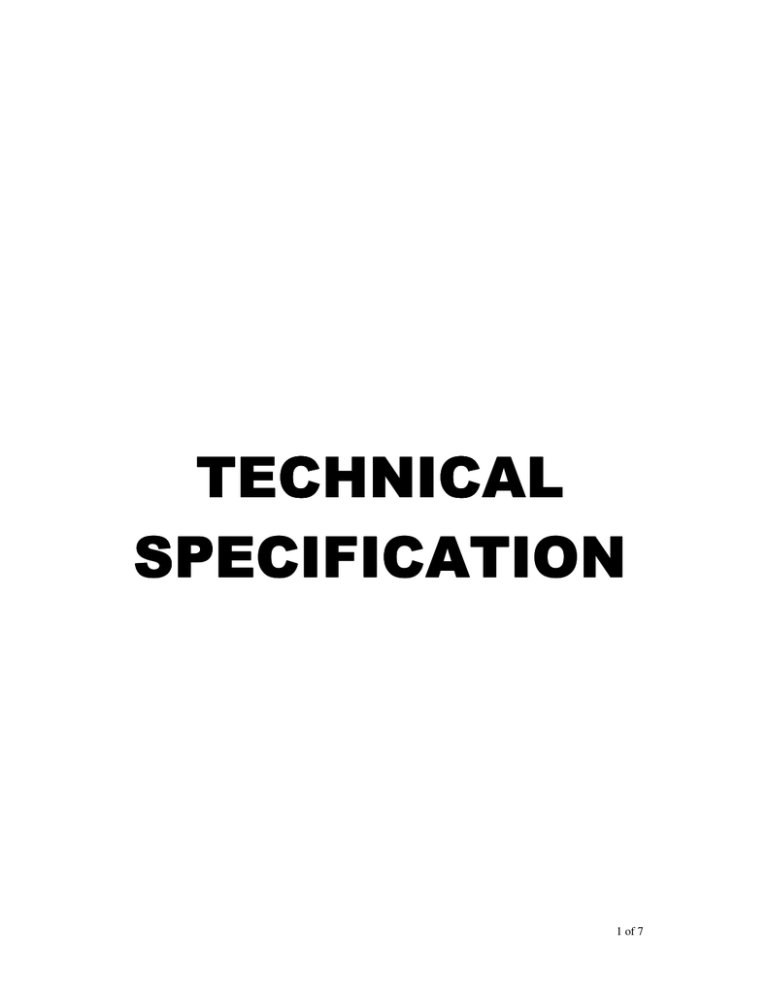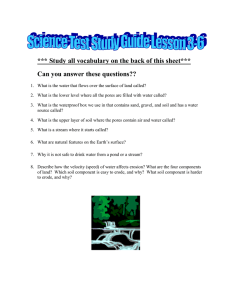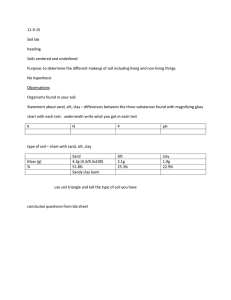5.SAND FILLING-TECHNICAL SPECIFICATIONS
advertisement

1 of 7 2 of 7 TECHNICAL SPECIFICATIONS - CIVIL - MATERIALS 1.0 WATER 1.1 Water used shall be clean and free from organic impurities etc and shall conform to IS-456 Latest Edition. Potable water is considered satisfactory for construction purpose. Water for construction purpose shall be tested for suitability as per IS codes at the start of the project and also at every three months interval. Periodicity: One test at the beginning of the project and once in every change of source SILVER SAND FOR FILLING Tests to be conducted a. Particle size - Lab b. Silt content - Field c. Bulking of sand-Field d. Percentage of Deleterious material / Organic impurities - lab Is code for material - IS-383-1970 IS code for testing - IS-2386 (Part I) to IS-2386 (Part VIII) Periodicity of testing 1.For every 5000 MT 2.Whenever there is a change in source of supply or as directed by the Engineer-in-Charge. Remarks 1. Silt content should not exceed 8%. The tests shall be conducted and certified by third parties namely reputed Engineering Institutes like IIT, Kharagpur, Jadavpur University, DCL, M.N. Dastur or other Engineering Institutes/Consultant of the like duly approved by HPCL. 3 of 7 Sand Filling (Silver Sand) The sand shall be clean ,dry,coarse,hard,angular,free from coatings of clay,dust and mix of vegetable and organic matters Use of dust like sand for this job is prohibited.It is recommended to wash the sand prior to use. Reduced level of subgrade shall be taken on a grid of 5m x 5m,co-ordinate wise w.r.t benchmark.Job includes setting out of work like fixing of BM for 0 deg, 90 deg,180 deg and 270 deg on all four directions.The same shall be plotted on construction drawing to be prepared by contractor for HPCL’s approval. Sand layer shall be laid in 200 mm loose layer well/thoroughly compacted to achieve 85 % relative density. For compaction, vibro compactor roller shall be used.For localized areas plate vibrator shall be deployed. For each layer one test has to be done @ 400 sqm. 4 of 7 • PROCEDURE FOR FIELD COMPACTION OF SAND LAYER. • • • Equipment type: vibrating base plate contractor. application: for coarse grained sand/soil Procedure: loose filling of sand layer is spread on the filling area of max. 200 mm thick. Moisture content of the sand is maintained below 5%.the compaction should be carried out with single pads or plates of min. 90 kg may be used tender where working plate available. Vibratory frequency shall be greater than 1600 cycles per minute. Minimum no. of passes or coverages shall be 3. Relative density of the sand layer is measured in field /lot and no. of passes or coverages are manipulated to obtain 85% relative density. The next layer is filled on compacted layer and above procedure is repeated until it reaches the desired level. 1. Procedure for the determination of minimum density The pouring device and mould should be selected according to the maximum size of particle as indicated in Table 1 of IS:2720 Part 14.The mould should be weighed and the mass recorded .Oven dry soils should be used. Soil containing particles smaller than 4.75mm should be placed as loosely as possible in the mould by pouring the soil through the spout in a steady stream. The spout should be adjusted so that the height of free fall of the soil is always 25mm.While pouring the soil the pouring device should be moved in a spiral motion from the outside towards centre to form soil layer of uniform without segregation. The mould should be filled approximately 25mm above the top and levelled by making one continuous pass with the steel straight edge .If all excess matter is not removed, an additional continuous pass should be made. Great care shall be exercised to avoid jarring the mould during the entire pouring and trimming operation. The mould and the soil should be weighed and the mass recorded. Soil containing particles larger than 4.75mm should be placed by means of a large scoop(or shovel) held as close as possible to and just above the soil surface to cause the material to slide rather than fall into the previously placed soil. If necessary ,large particles may be held by hand to prevent them from rolling off the scoop. The mould should be filled to overflowing but not more than 25mm above the top .The surface of the soil should be levelled with the top of the mould using the steel straight edge(and the 5 of 7 fingers ,if necessary) in such a way that any slight projection of the larger particles above the top of mould shall approximately balance the larger voids in the surface below the top of the mould. The mould and the soil should be weighed and the mass recorded. 2. PROCEDURE FOR DETERMINATION OF MAXIMUM DENSITY. The maximum density may be determined by dry method. The guide sleeve should be assembled on top of the mould and clamp assemblies tightened so that the inner surfaces of the walls of the mould and the sleeve are in the line. The lock nuts on the two set screws equipped with them should be tightened. The third clamp should be loosened, the guide sleeve removed, the empty mould weighed and its mass recorded. The mould should be then filled the thoroughly mixed oven dry sand by the procedure explained as above. The mould filled for the determination of minimum density can also be used for this test. The guide sleeves should attached to the mould and surcharge base plate should placed on the soil surface. The surcharge weight then should be lowered on the base plate using the hoist in the case of the 15000 cm3 mould. The mould should be fixed to the vibrator deck assembly. The vibrator control should be set at max. Amplitude and the loaded specimen should be vibrated for 8 minutes. Calculations: Minimum density The minimum density, Y min, in g/cm3 should be calculated as follows: Y min = W gm/Vc Where, Wgm = mass of dry soil in the minimum density test in gram ; and Vc = calibrated volume in the mould in cm3. Maximum density The maximum density calculated as follows: Y max = Ws/Vs 6 of 7 Where: Ws= mass of dry soil in the maximum density test in grams. Vs=volume of soil in maximum density test in cm3 = Vc-(Di-Df)A; Di = initial dial guage reading in cm Df= final dial guage reading on the surcharge plate. Density index (relative density): The density index expressed as a percentage should be calculated as follows: Id (or Dr) = Y max (Y d - Y min)/ Y d ( Y max- Y min) In terms of void ratio Id= ( [ emax-e]/[emax-emin])*100 emax=void ratio of the soil in loosest state e=void ratio of the soil in the field emin=void ration of the soil in the densest state 7 of 7



